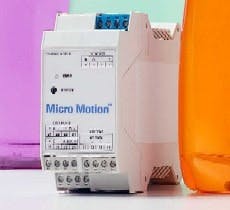Click here for larger image.The new Micro Motion 1500 filling and dosing transmitter from Emerson Process Management offers a solution for precise control of the filling process. Using Micro Motion Coriolis sensors, the Model 1500 integrates easily into the machine control system and directly controls pumps and valves.The integrated system simplifies the batch delivery control loop, eliminating the need for separate controllers, resulting in removal of communication time delays, and improved fill accuracy and response time. In life sciences installations, the new system is part of Emerson’s OpX Advantage program for operational excellence.For improved filling and dosing, Micro Motion Coriolis flowmeters provide manufacturers of filling machines with a direct mass flow measurement, accurate to better than 0.1%. These meters are used in control loops with the new Micro Motion 1500 filling and dosing transmitter that delivers precise, intelligent control of the filling process, in a small, compact DIN rail solution.The direct, predictive valve control from the Micro Motion transmitter uses measurements of each delivery to optimize the control accuracy for subsequent fills, and improves profitability by reducing product give-away. Integration of the Micro Motion flowmeter into the valve control system also gives a faster response, by eliminating the normal pulse train linking the flowmeter to the controller.Efficiency benefits arise from close integration of the Micro Motion Model 1500 within the filling machine, using simple RS485 Modbus protocol communications with the control panel software. The operator has the ability to fill a wide range of container sizes, modify delivery quantities for each ingredient, and instantly select an alternative menu to create different product ranges on a single machine.Productivity benefits arise from faster product changeover times on the delivery lines, using in-line CIP (clean-in-place) processes to efficiently clean the flowmeters. The ‘Strip-down and Clean’ cycle previously required to eliminate the cross contamination possible with mechanical flowmeter devices is eliminated. The same sensor, with no program changes, can handle liquids or pastes/creams with varying viscosity, temperature, entrained air or suspended solids, while measuring mass flow directly.The small size of the Micro Motion 1500 filling and dosing transmitter allows simple installation on a DIN rail in the machine control cabinet. The unit is designed for filling machines using short duration fill cycles, where all operator interface information is provided by the machine control panel, so it has no local display. With a built-in safety barrier, the transmitter can supply intrinsically safe power and wiring connections to the Micro Motion flow sensor, enabling their safe operation in hazardous areas, and reducing the cost and complexity of filling machine cabling systems.Manufacturers using the Micro Motion filling and dosing transmitter report reduced waste, improved product quality and faster product changeovers. The Micro Motion mass flow sensors enable the machine systems to work with a wide range of liquid feeds, in line sizes down to 0.1”, providing performance independent of temperature, viscosity and product changes. The need for any further check-weighing is eliminated. This all adds up to increased efficiency and profitability.With many manufacturers operating in an increasingly regulated environment, systems are available with 3A and EHEDG (European Hygienic Engineering and Design Group) certification for use on sanitary and aseptic processes, and the sensors are suitable for CIP and SIP (sanitize-in-place) processes. The Micro Motion-exclusive, patented MVD (MultiVariable Digital) technology in the mass flow transmitter provides monitoring of ingredient temperature and density, providing immediate quality assurance alarms for out-of-specification values, as well as records for later audits.
Request More Information
Request More Information
Related Content
Related Content
Emerson Process Management
Jan. 1, 2000
Quantifying technology’s impact on vaccination rates
Sept. 9, 2022
Unlocking the full potential of pharma batch reports
Aug. 12, 2022
Shortening the equipment qualification path
June 20, 2022
Circling back to digital initiatives in pharma
June 15, 2022





